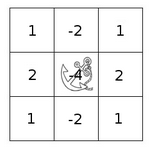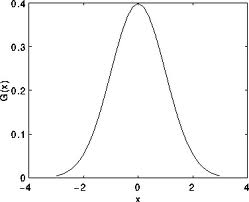Javascript图像处理—平滑处理实现原理_javascript技巧
前言
上一篇文章,我们讲解了图像的虚拟边缘,这篇文章开始进行平滑(也就是模糊)处理。
基本原理
这里直接引用OpenCV 2.4+ C++ 平滑处理和OpenCV 2.4+ C++ 边缘梯度计算的相关内容:
平滑也称模糊, 是一项简单且使用频率很高的图像处理方法。
平滑处理时需要用到一个滤波器
。 最常用的滤波器是线性 滤波器,线性滤波处理的输出像素值(例如:)是输入像素值(例如:
)的加权平均:
, 它仅仅是一个加权系数。
称为核
这里涉及一种叫做“卷积”的运算,那么卷积是什么呢?
卷积是在每一个图像块与某个算子(核)之间进行的运算。
核?!
nbsp;dsds
核就是一个固定大小的数值数组。该数组带有一个锚点
,一般位于数组中央。

可是这怎么运算啊?
假如你想得到图像的某个特定位置的卷积值,可用下列方法计算:
将核的锚点放在该特定位置的像素上,同时,核内的其他值与该像素邻域的各像素重合;将核内各值与相应像素值相乘,并将乘积相加;将所得结果放到与锚点对应的像素上;对图像所有像素重复上述过程。
用公式表示上述过程如下:
在图像边缘的卷积怎么办呢?
计算卷积前,需要通过复制源图像的边界创建虚拟像素,这样边缘的地方也有足够像素计算卷积了。这就是为什么上一篇文章需要做虚拟边缘函数。
均值平滑
均值平滑实际上就是内核元素全是1的卷积运算,然后再除以内核的大小,用数学表达式来表示就是:

下面我们来实现均值平滑函数blur:
function blur(__src, __size1, __size2, __borderType, __dst){
if(__src.type && __src.type == "CV_RGBA"){
var height = __src.row,
width = __src.col,
dst = __dst || new Mat(height, width, CV_RGBA),
dstData = dst.data;
var size1 = __size1 || 3,
size2 = __size2 || size1,
size = size1 * size2;
if(size1 % 2 !== 1 || size2 % 2 !== 1){
console.error("size大小必须是奇数");
return __src;
}
var startX = Math.floor(size1 / 2),
startY = Math.floor(size2 / 2);
var withBorderMat = copyMakeBorder(__src, startY, startX, 0, 0, __borderType),
mData = withBorderMat.data,
mWidth = withBorderMat.col;
var newValue, nowX, offsetY, offsetI;
var i, j, c, y, x;
for(i = height; i--;){
offsetI = i * width;
for(j = width; j--;){
for(c = 3; c--;){
newValue = 0;
for(y = size2; y--;){
offsetY = (y + i) * mWidth * 4;
for(x = size1; x--;){
nowX = (x + j) * 4 + c;
newValue += mData[offsetY + nowX];
}
}
dstData[(j + offsetI) * 4 + c] = newValue / size;
}
dstData[(j + offsetI) * 4 + 3] = mData[offsetY + startY * mWidth * 4 + (j + startX) * 4 + 3];
}
}
}else{
console.error("不支持类型。");
}
return dst;
}
其中size1和size2分别是核的横向和纵向大小,并且必须是正奇数。
高斯平滑
最有用的滤波器 (尽管不是最快的)。 高斯滤波是将输入数组的每一个像素点与高斯内核
卷积将卷积和当作输出像素值。
参考一维高斯函数,我们可以看见,他是个中间大两边小的函数。
所以高斯滤波器其加权数是中间大,四周小的。
其二维高斯函数为:

其中
 为均值 (峰值对应位置),
为均值 (峰值对应位置),
 代表标准差 (变量
代表标准差 (变量
 和 变量
和 变量
 各有一个均值,也各有一个标准差)。
各有一个均值,也各有一个标准差)。
这里参考OpenCV的实现,不过应该还有优化空间,因为还没用到分离滤波器。
首先我们做一个getGaussianKernel来返回高斯滤波器的一维数组。
function getGaussianKernel(__n, __sigma){
var SMALL_GAUSSIAN_SIZE = 7,
smallGaussianTab = [[1],
[0.25, 0.5, 0.25],
[0.0625, 0.25, 0.375, 0.25, 0.0625],
[0.03125, 0.109375, 0.21875, 0.28125, 0.21875, 0.109375, 0.03125]
];
var fixedKernel = __n & 2 == 1 && __n > 1] : 0;
var sigmaX = __sigma > 0 ? __sigma : ((__n - 1) * 0.5 - 1) * 0.3 + 0.8,
scale2X = -0.5 / (sigmaX * sigmaX),
sum = 0;
var i, x, t, kernel = [];
for(i = 0; i x = i - (__n - 1) * 0.5;
t = fixedKernel ? fixedKernel[i] : Math.exp(scale2X * x * x);
kernel[i] = t;
sum += t;
}
sum = 1 / sum;
for(i = __n; i--;){
kernel[i] *= sum;
}
return kernel;
};
然后通过两个这个一维数组,便可以计算出一个完整的高斯内核,再利用blur里面用到的循环方法,就可以算出高斯平滑后的矩阵了。
function GaussianBlur(__src, __size1, __size2, __sigma1, __sigma2, __borderType, __dst){
if(__src.type && __src.type == "CV_RGBA"){
var height = __src.row,
width = __src.col,
dst = __dst || new Mat(height, width, CV_RGBA),
dstData = dst.data;
var sigma1 = __sigma1 || 0,
sigma2 = __sigma2 || __sigma1;
var size1 = __size1 || Math.round(sigma1 * 6 + 1) | 1,
size2 = __size2 || Math.round(sigma2 * 6 + 1) | 1,
size = size1 * size2;
if(size1 % 2 !== 1 || size2 % 2 !== 1){
console.error("size必须是奇数。");
return __src;
}
var startX = Math.floor(size1 / 2),
startY = Math.floor(size2 / 2);
var withBorderMat = copyMakeBorder(__src, startY, startX, 0, 0, __borderType),
mData = withBorderMat.data,
mWidth = withBorderMat.col;
var kernel1 = getGaussianKernel(size1, sigma1),
kernel2,
kernel = new Array(size1 * size2);
if(size1 === size2 && sigma1 === sigma2)
kernel2 = kernel1;
else
kernel2 = getGaussianKernel(size2, sigma2);
var i, j, c, y, x;
for(i = kernel2.length; i--;){
for(j = kernel1.length; j--;){
kernel[i * size1 + j] = kernel2[i] * kernel1[j];
}
}
var newValue, nowX, offsetY, offsetI;
for(i = height; i--;){
offsetI = i * width;
for(j = width; j--;){
for(c = 3; c--;){
newValue = 0;
for(y = size2; y--;){
offsetY = (y + i) * mWidth * 4;
for(x = size1; x--;){
nowX = (x + j) * 4 + c;
newValue += (mData[offsetY + nowX] * kernel[y * size1 + x]);
}
}
dstData[(j + offsetI) * 4 + c] = newValue;
}
dstData[(j + offsetI) * 4 + 3] = mData[offsetY + startY * mWidth * 4 + (j + startX) * 4 + 3];
}
}
}else{
console.error("不支持的类型");
}
return dst;
}
中值平滑
中值滤波将图像的每个像素用邻域 (以当前像素为中心的正方形区域)像素的
中值代替 。依然使用blur里面用到的循环,只要得到核中的所有值,再通过sort排序便可以得到中值,然后锚点由该值替代。
function medianBlur(__src, __size1, __size2, __borderType, __dst){
if(__src.type && __src.type == "CV_RGBA"){
var height = __src.row,
width = __src.col,
dst = __dst || new Mat(height, width, CV_RGBA),
dstData = dst.data;
var size1 = __size1 || 3,
size2 = __size2 || size1,
size = size1 * size2;
if(size1 % 2 !== 1 || size2 % 2 !== 1){
console.error("size必须是奇数");
return __src;
}
var startX = Math.floor(size1 / 2),
startY = Math.floor(size2 / 2);
var withBorderMat = copyMakeBorder(__src, startY, startX, 0, 0, __borderType),
mData = withBorderMat.data,
mWidth = withBorderMat.col;
var newValue = [], nowX, offsetY, offsetI;
var i, j, c, y, x;
for(i = height; i--;){
offsetI = i * width;
for(j = width; j--;){
for(c = 3; c--;){
for(y = size2; y--;){
offsetY = (y + i) * mWidth * 4;
for(x = size1; x--;){
nowX = (x + j) * 4 + c;
newValue[y * size1 + x] = mData[offsetY + nowX];
}
}
newValue.sort();
dstData[(j + offsetI) * 4 + c] = newValue[Math.round(size / 2)];
}
dstData[(j + offsetI) * 4 + 3] = mData[offsetY + startY * mWidth * 4 + (j + startX) * 4 + 3];
}
}
}else{
console.error("类型不支持");
}
return dst;
};

Heiße KI -Werkzeuge

Undresser.AI Undress
KI-gestützte App zum Erstellen realistischer Aktfotos

AI Clothes Remover
Online-KI-Tool zum Entfernen von Kleidung aus Fotos.

Undress AI Tool
Ausziehbilder kostenlos

Clothoff.io
KI-Kleiderentferner

Video Face Swap
Tauschen Sie Gesichter in jedem Video mühelos mit unserem völlig kostenlosen KI-Gesichtstausch-Tool aus!

Heißer Artikel

Heiße Werkzeuge

Notepad++7.3.1
Einfach zu bedienender und kostenloser Code-Editor

SublimeText3 chinesische Version
Chinesische Version, sehr einfach zu bedienen

Senden Sie Studio 13.0.1
Leistungsstarke integrierte PHP-Entwicklungsumgebung

Dreamweaver CS6
Visuelle Webentwicklungstools

SublimeText3 Mac-Version
Codebearbeitungssoftware auf Gottesniveau (SublimeText3)

Heiße Themen
 1393
1393
 52
52
 Wie wird die Wasserstein-Distanz bei Bildverarbeitungsaufgaben verwendet?
Jan 23, 2024 am 10:39 AM
Wie wird die Wasserstein-Distanz bei Bildverarbeitungsaufgaben verwendet?
Jan 23, 2024 am 10:39 AM
Die Wasserstein-Distanz, auch EarthMover-Distanz (EMD) genannt, ist eine Metrik zur Messung der Differenz zwischen zwei Wahrscheinlichkeitsverteilungen. Im Vergleich zur herkömmlichen KL-Divergenz oder JS-Divergenz berücksichtigt die Wasserstein-Distanz die Strukturinformationen zwischen Verteilungen und weist daher bei vielen Bildverarbeitungsaufgaben eine bessere Leistung auf. Durch die Berechnung der minimalen Transportkosten zwischen zwei Verteilungen ist die Wasserstein-Distanz in der Lage, den minimalen Arbeitsaufwand zu messen, der erforderlich ist, um eine Verteilung in eine andere umzuwandeln. Diese Metrik ist in der Lage, die geometrischen Unterschiede zwischen Verteilungen zu erfassen und spielt daher eine wichtige Rolle bei Aufgaben wie der Bilderzeugung und der Stilübertragung. Daher wird die Wasserstein-Distanz zum Konzept
 Eingehende Analyse der Funktionsprinzipien und Eigenschaften des Vision Transformer (VIT)-Modells
Jan 23, 2024 am 08:30 AM
Eingehende Analyse der Funktionsprinzipien und Eigenschaften des Vision Transformer (VIT)-Modells
Jan 23, 2024 am 08:30 AM
VisionTransformer (VIT) ist ein von Google vorgeschlagenes Transformer-basiertes Bildklassifizierungsmodell. Im Gegensatz zu herkömmlichen CNN-Modellen stellt VIT Bilder als Sequenzen dar und lernt die Bildstruktur durch Vorhersage der Klassenbezeichnung des Bildes. Um dies zu erreichen, unterteilt VIT das Eingabebild in mehrere Patches, verkettet die Pixel in jedem Patch über Kanäle und führt dann eine lineare Projektion durch, um die gewünschten Eingabeabmessungen zu erreichen. Schließlich wird jeder Patch zu einem einzelnen Vektor zusammengefasst, der die Eingabesequenz bildet. Durch den Selbstaufmerksamkeitsmechanismus von Transformer ist VIT in der Lage, die Beziehung zwischen verschiedenen Patches zu erfassen und eine effektive Merkmalsextraktion und Klassifizierungsvorhersage durchzuführen. Diese serialisierte Bilddarstellung ist
 Anwendung der KI-Technologie bei der hochauflösenden Bildrekonstruktion
Jan 23, 2024 am 08:06 AM
Anwendung der KI-Technologie bei der hochauflösenden Bildrekonstruktion
Jan 23, 2024 am 08:06 AM
Bei der superauflösenden Bildrekonstruktion werden hochauflösende Bilder aus Bildern mit niedriger Auflösung mithilfe von Deep-Learning-Techniken wie Convolutional Neural Networks (CNN) und Generative Adversarial Networks (GAN) generiert. Das Ziel dieser Methode besteht darin, die Qualität und Detailgenauigkeit von Bildern zu verbessern, indem Bilder mit niedriger Auflösung in Bilder mit hoher Auflösung umgewandelt werden. Diese Technologie findet breite Anwendung in vielen Bereichen, beispielsweise in der medizinischen Bildgebung, Überwachungskameras, Satellitenbildern usw. Durch die hochauflösende Bildrekonstruktion können wir klarere und detailliertere Bilder erhalten, die dabei helfen, Ziele und Merkmale in Bildern genauer zu analysieren und zu identifizieren. Rekonstruktionsmethoden Hochauflösende Bildrekonstruktionsmethoden können im Allgemeinen in zwei Kategorien unterteilt werden: interpolationsbasierte Methoden und Deep-Learning-basierte Methoden. 1) Interpolationsbasierte Methode Hochauflösende Bildrekonstruktion basierend auf Interpolation
 Umgang mit Bildverarbeitungs- und Grafikschnittstellendesign-Problemen in der C#-Entwicklung
Oct 08, 2023 pm 07:06 PM
Umgang mit Bildverarbeitungs- und Grafikschnittstellendesign-Problemen in der C#-Entwicklung
Oct 08, 2023 pm 07:06 PM
Für den Umgang mit Bildverarbeitungs- und grafischen Schnittstellendesignproblemen in der C#-Entwicklung sind spezifische Codebeispiele erforderlich. Einführung: In der modernen Softwareentwicklung sind Bildverarbeitung und grafisches Schnittstellendesign gängige Anforderungen. Als universelle Programmiersprache auf hoher Ebene verfügt C# über leistungsstarke Bildverarbeitungs- und grafische Schnittstellendesignfunktionen. Dieser Artikel basiert auf C#, erläutert den Umgang mit Bildverarbeitungs- und Grafikschnittstellendesign-Problemen und gibt detaillierte Codebeispiele. 1. Probleme bei der Bildverarbeitung: Lesen und Anzeigen von Bildern: In C# sind das Lesen und Anzeigen von Bildern grundlegende Vorgänge. Kann verwendet werden.N
 Java-Entwicklung: So implementieren Sie die Bilderkennung und -verarbeitung
Sep 21, 2023 am 08:39 AM
Java-Entwicklung: So implementieren Sie die Bilderkennung und -verarbeitung
Sep 21, 2023 am 08:39 AM
Java-Entwicklung: Ein praktischer Leitfaden zur Bilderkennung und -verarbeitung Zusammenfassung: Mit der rasanten Entwicklung von Computer Vision und künstlicher Intelligenz spielen Bilderkennung und -verarbeitung in verschiedenen Bereichen eine wichtige Rolle. In diesem Artikel wird erläutert, wie die Java-Sprache zum Implementieren der Bilderkennung und -verarbeitung verwendet wird, und es werden spezifische Codebeispiele bereitgestellt. 1. Grundprinzipien der Bilderkennung Unter Bilderkennung versteht man den Einsatz von Computertechnologie zur Analyse und zum Verständnis von Bildern, um Objekte, Merkmale oder Inhalte im Bild zu identifizieren. Bevor wir die Bilderkennung durchführen, müssen wir einige grundlegende Bildverarbeitungstechniken verstehen, wie in der Abbildung dargestellt
 Wie man KI-Technologie nutzt, um alte Fotos wiederherzustellen (mit Beispielen und Code-Analyse)
Jan 24, 2024 pm 09:57 PM
Wie man KI-Technologie nutzt, um alte Fotos wiederherzustellen (mit Beispielen und Code-Analyse)
Jan 24, 2024 pm 09:57 PM
Bei der Restaurierung alter Fotos handelt es sich um eine Methode zur Nutzung künstlicher Intelligenz, um alte Fotos zu reparieren, aufzuwerten und zu verbessern. Mithilfe von Computer-Vision- und maschinellen Lernalgorithmen kann die Technologie Schäden und Unvollkommenheiten in alten Fotos automatisch erkennen und reparieren, sodass diese klarer, natürlicher und realistischer aussehen. Die technischen Prinzipien der Restaurierung alter Fotos umfassen hauptsächlich die folgenden Aspekte: 1. Bildrauschen und -verbesserung Bei der Wiederherstellung alter Fotos müssen diese zunächst entrauscht und verbessert werden. Bildverarbeitungsalgorithmen und -filter wie Mittelwertfilterung, Gaußsche Filterung, bilaterale Filterung usw. können zur Lösung von Rausch- und Farbfleckproblemen eingesetzt werden, wodurch die Qualität von Fotos verbessert wird. 2. Bildwiederherstellung und -reparatur Bei alten Fotos können einige Mängel und Schäden wie Kratzer, Risse, Ausbleichen usw. auftreten. Diese Probleme können durch Bildwiederherstellungs- und Reparaturalgorithmen gelöst werden
 PHP-Studiennotizen: Gesichtserkennung und Bildverarbeitung
Oct 08, 2023 am 11:33 AM
PHP-Studiennotizen: Gesichtserkennung und Bildverarbeitung
Oct 08, 2023 am 11:33 AM
Anmerkungen zur PHP-Studie: Gesichtserkennung und Bildverarbeitung Vorwort: Mit der Entwicklung der Technologie der künstlichen Intelligenz sind Gesichtserkennung und Bildverarbeitung zu heißen Themen geworden. In praktischen Anwendungen werden Gesichtserkennung und Bildverarbeitung hauptsächlich bei der Sicherheitsüberwachung, Gesichtsentsperrung, Kartenvergleich usw. eingesetzt. Als häufig verwendete serverseitige Skriptsprache können mit PHP auch Funktionen zur Gesichtserkennung und Bildverarbeitung implementiert werden. Dieser Artikel führt Sie anhand spezifischer Codebeispiele durch die Gesichtserkennung und Bildverarbeitung in PHP. 1. Gesichtserkennung in PHP Gesichtserkennung ist eine
 SIFT-Algorithmus (Scale Invariant Features).
Jan 22, 2024 pm 05:09 PM
SIFT-Algorithmus (Scale Invariant Features).
Jan 22, 2024 pm 05:09 PM
Der Scale Invariant Feature Transform (SIFT)-Algorithmus ist ein Merkmalsextraktionsalgorithmus, der in den Bereichen Bildverarbeitung und Computer Vision verwendet wird. Dieser Algorithmus wurde 1999 vorgeschlagen, um die Objekterkennung und die Matching-Leistung in Computer-Vision-Systemen zu verbessern. Der SIFT-Algorithmus ist robust und genau und wird häufig in der Bilderkennung, dreidimensionalen Rekonstruktion, Zielerkennung, Videoverfolgung und anderen Bereichen eingesetzt. Es erreicht Skaleninvarianz, indem es Schlüsselpunkte in mehreren Skalenräumen erkennt und lokale Merkmalsdeskriptoren um die Schlüsselpunkte herum extrahiert. Zu den Hauptschritten des SIFT-Algorithmus gehören die Skalenraumkonstruktion, die Erkennung von Schlüsselpunkten, die Positionierung von Schlüsselpunkten, die Richtungszuweisung und die Generierung von Merkmalsdeskriptoren. Durch diese Schritte kann der SIFT-Algorithmus robuste und einzigartige Merkmale extrahieren und so eine effiziente Bildverarbeitung erreichen.




 )是输入像素值(例如:
)是输入像素值(例如: )的加权平均:
)的加权平均:

 称为核
称为核
